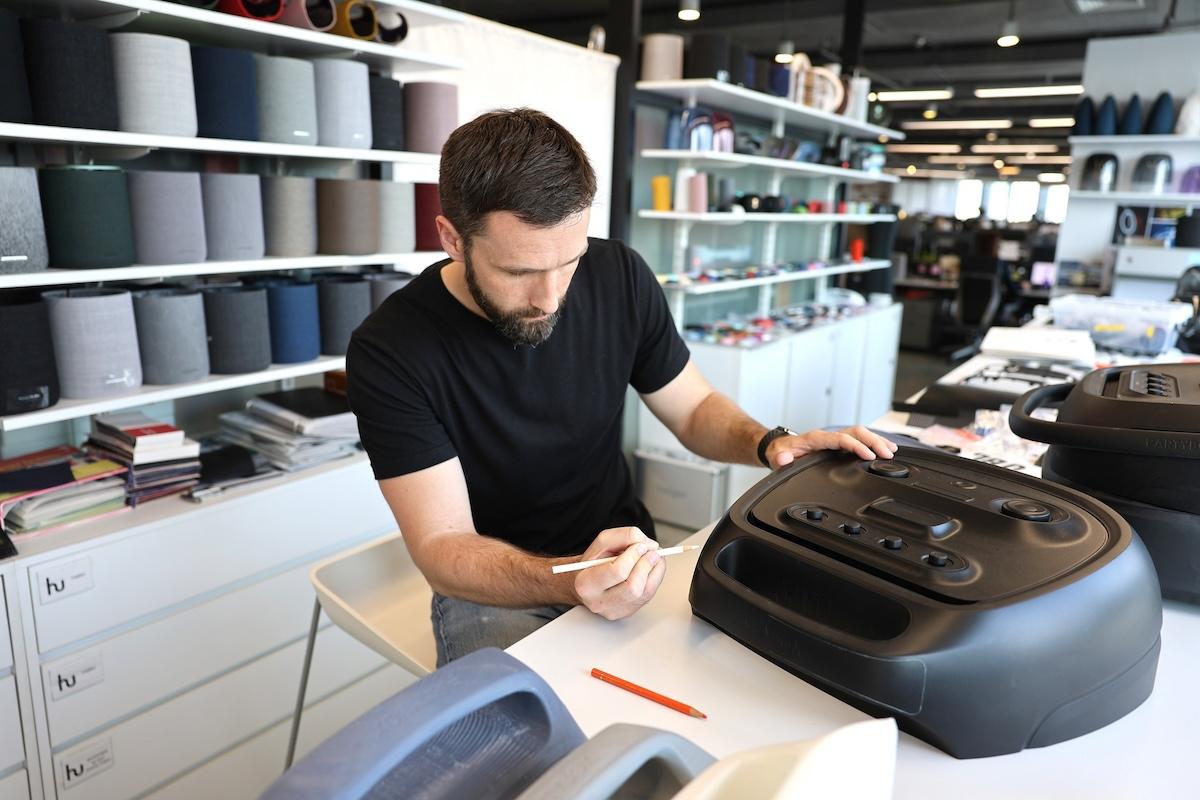HARMAN: Designing With Purpose Is a Team Sport
By James Billington
Published 05-01-24
Submitted by HARMAN

Originally published on HARMAN Newsroom
Collaboration is more than a buzzword. It's a transformative practice that breeds innovation and creativity, turning design processes into opportunities for ideation and problem-solving.
Collaborative design is a best practice employed across a breadth of businesses that use in-house design firms so multiple project stakeholders can share real-time perspectives and feedback through all stages of the design process. By adopting this model, the audio industry has made generational leaps — designing speakers, headphones and innovative products that are the realization of dynamic teamwork.
"Integration means we, as product designers, have the chance to work on building brands rather than just single products. We always try to see the bigger picture when we make design decisions," said Jonas Ceppa, a senior industrial designer at Huemen — the integrated design arm of HARMAN.
Teamwork Makes the Dream Work
Ceppa understands first-hand the importance and game-changing advantages collaboration offers to the product development process. Responsible for leading the next generation of design for JBL portable party loudspeakers, Ceppa's team’s vision was to create a one-of-a-kind product — the PartyBox Ultimate. To achieve this goal, collaborative design was essential.
"Huemen designers are part of the process from the very early stage of developing the product concept. At the same time, we collaborate with our mechanical and acoustic engineering team to ensure the product vision can be realized," Ceppa explained.
Drawing on a passionate and talented global team, Ceppa took a holistic approach to the product development process. The result was the PartyBox Ultimate — the most powerful party speaker from JBL, with JBL Pro sound and bass integrated into a futuristic enclosure that transcends the typical speaker audio experience.
"With PartyBox Ultimate, we launched a new generation of PartyBoxes, where we have defined several ingredients that are going to have a huge impact on all upcoming products in the line," said Ceppa.
The JBL PartyBox Ultimate presents an alluring lightshow display that sweeps from the front elegantly around the sides of the product with an innovative dynamic edge, creating a distinct outline around its striking front-facing subwoofers, which accentuates its distinctive silhouette even in low-light conditions. The groundbreaking PartyBox Ultimate stimulates both aural and optical senses to create an immersive audiovisual experience.
From starry night to strobe effects, it is a speaker design that can transform any space into a spirited lightshow and awaken all the senses. It's the ultimate party in a box.
Behind the Music
For the HARMAN product team to create a loudspeaker that would take the audio experience to new heights, it had to deliver another dimension in addition to superior sonic ability.
A consumer survey conducted by HARMAN revealed that 84% of respondents believe feeling immersed in the sound enhances the intensity of emotions, and 83% claim to feel a higher emotional effect with a better sound quality. So, how could the team magnify this feeling and further elevate the value of sound? The answer was in the design.
In the same survey, 64% claimed that design creates an immersive and elaborate audio experience.
"For this category of party loudspeakers, we have a very clear target group," Ceppa explained. "They are young, energetic, share their favorite music and want to inspire others. This is an important factor that will go into the design creation from the beginning."

Creating an Audio Icon
During the PartyBox design journey, Ceppa revealed several challenges from which moments of inspiration “combined to become part of the design language.”
A rich resource of engineering, manufacturing, and design teams helped Ceppa overcome hurdles and push boundaries with collaborative, problem-solving solutions.
"These different teams bring in their knowledge to push our ideas even further by sharing new material exploration, manufacturing techniques and acoustic prototypes."
Ceppa described the moment they discovered the unique metal grille design that could be applied to the new generation of the PartyBoxes: “After several trials, even including new manufacturing technologies, we couldn’t find a satisfying pattern. We tried different shapes, forms and repetitions … I realized sitting in front of the prototype that we had a very unique shape we could use all along — the figure eight.”
Such moments of serendipity also helped shape the PartyBox’s signature lightshow feature. As Ceppa revealed, influences from other design-led industries were the genesis for his inspired “lightbulb moment.”
“The initial idea for the lightshow was simple: We wanted to create something new, outstanding and a visible improvement to the previous generation. Inspiration came from sci-fi movies, concept cars and automotive light design. But one of the key moments happened when we decided to not only incorporate the light on the front of the speaker but also the side. This created a more three-dimensional lightshow effect and described the outer shape of the speaker just with light.”
Thanks to a synergy of ID, UI, UX, packaging engineering, graphic design and digital art teams, the PartyBox Ultimate has a strong brand presence and an iconic silhouette. Illuminated by the innovative lightshow, the powerful bass and acoustic performance stirs emotion.
"Being able to develop a design in great detail and guide it until it reaches the market is very important," Ceppa said. "You want to ensure that the initial design vision is kept along the way without major compromise.”

A Symphony of Minds
At every stage, functional and design teams at HARMAN and Huemen combined and contributed to play a pivotal role in designing with purpose. The early collaboration between industrial designers and acoustic engineering teams ensured that the initial design vision was not only preserved but enhanced through shared expertise.
Another key advantage of collaborative design is the ability to provide immediate feedback and iterate on designs swiftly. This iterative refinement ensures that the final product aligns closely with the initial design vision.
"For physical products, it is important to experience the size, volume, material, and functional features, especially in the early development phase," Ceppa highlighted. "We build all our designs in 3D software, but to judge the size and shape it is important to experience the physical object. When we review the first mock-ups or prototypes, we can give immediate feedback or revise our design to improve the product."
After sketching and building the initial design for weeks, the excitement when seeing the first full-scale physical prototype was a memorable experience for Ceppa and his team.
“Receiving the first cosmetic mock-ups and prototypes feels like unwrapping Christmas presents because you are so excited to see what’s inside the box. We could tell instantly that just from the overall size and volume of the first prototype, PartyBox Ultimate will be perceived as the most powerful party speaker,” he said.
“It was worth the wait. The new lightshow elements with its precise light lines and dynamic movement looked amazing and topped everything that we had seen before on a party speaker.”
The dynamism and efficiency of working across integrated teams led the project to evolve from Ceppa's inspired sketches to boundary-pushing technological development, engineering, and, ultimately, a successful delivery.
From creative minds shaping the external aesthetics to engineers refining the internal acoustics, the PartyBox Ultimate is a prime example of how the collaboration of diverse talents on different teams can result in a product that is both aesthetically pleasing and acoustically superior, setting the tone for the future — literally.

HARMAN
HARMAN
ABOUT HARMAN
HARMAN International (harman.com), a wholly-owned subsidiary of Samsung Electronics Co, LTD., designs and engineers connected products and solutions for automakers, consumers, and enterprises worldwide, including connected car systems, audio and visual products, enterprise automation solutions; and services supporting the Internet of Things. With leading brands including AKG®, Harman Kardon®, Infinity®, JBL®, Lexicon®, Mark Levinson® and Revel®, HARMAN is admired by audiophiles, musicians and the entertainment venues where they perform around the world. More than 25 million automobiles on the road today are equipped with HARMAN audio and connected car systems. Our software services power billions of mobile devices and systems that are connected, integrated and secure across all platforms, from work and home to car and mobile. HARMAN has a workforce of approximately 30,000 people across the Americas, Europe, and Asia. In 2017, HARMAN became a wholly-owned subsidiary of Samsung Electronics.
More from HARMAN

